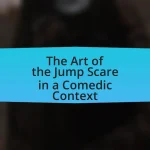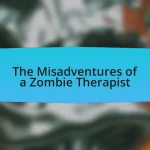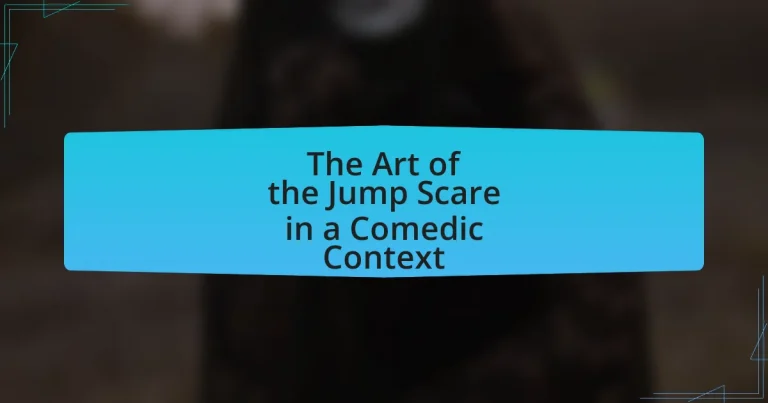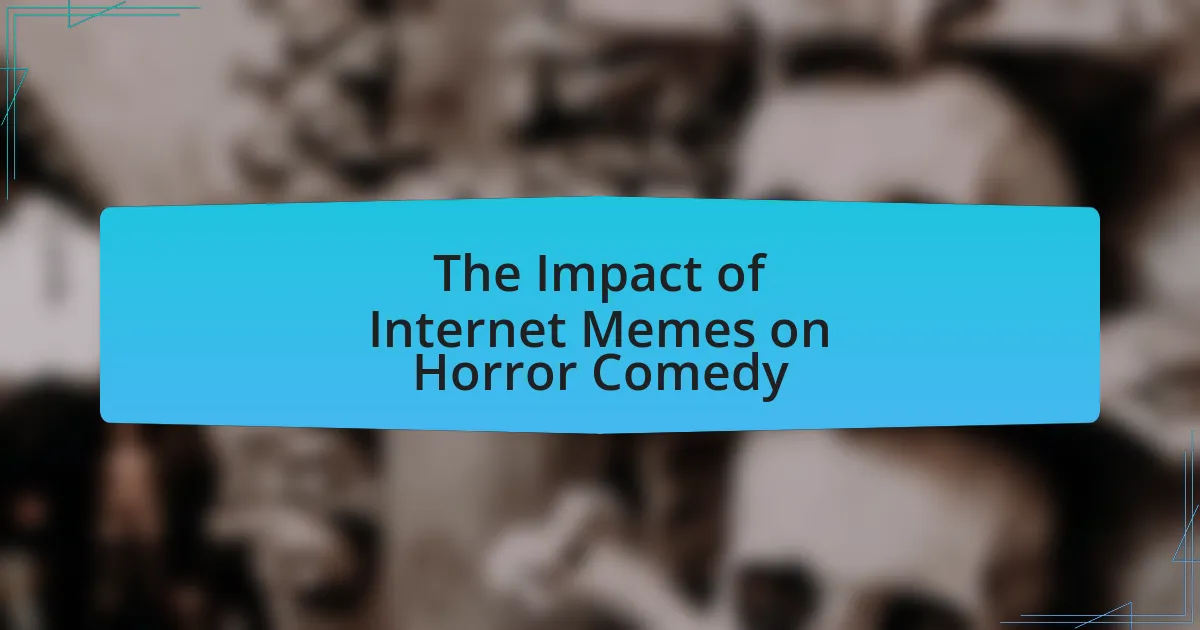The article explores the art of jump scares within a comedic context, highlighting how these sudden, unexpected moments can elicit laughter instead of fear. It examines the mechanics of comedic jump scares, including their function in narratives, the importance of timing and delivery, and the psychological mechanisms that make them effective. Key differences between comedic and traditional jump scares are discussed, along with notable examples from films like “Scary Movie” and “What We Do in the Shadows.” The article also addresses the challenges creators face when incorporating jump scares into comedy and offers best practices for successful implementation.
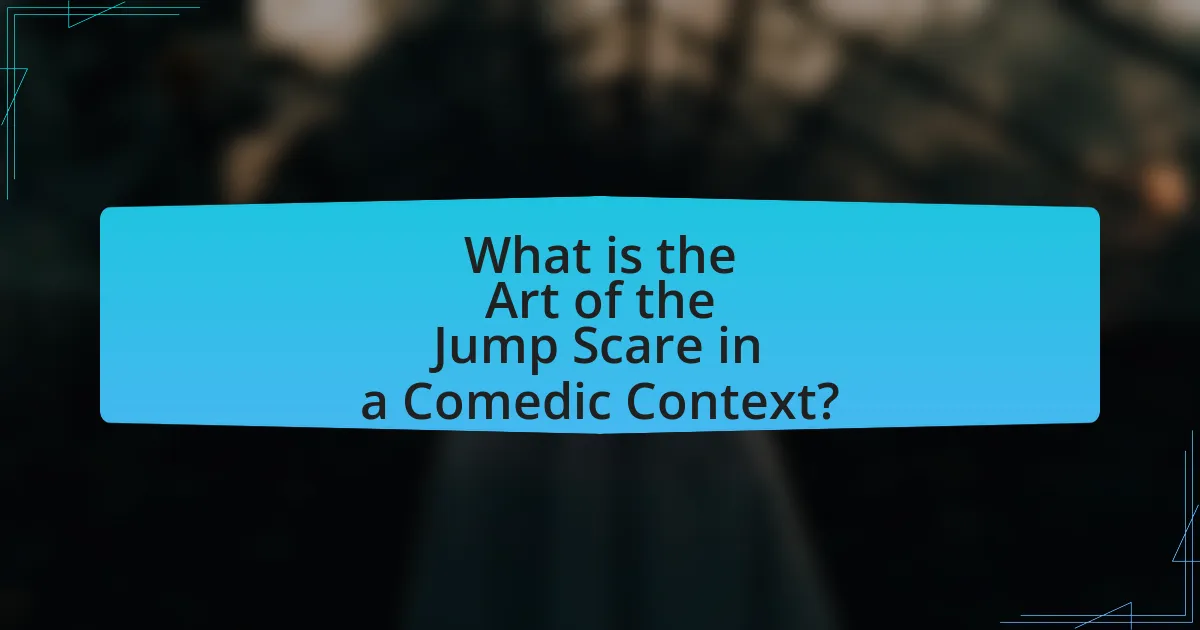
What is the Art of the Jump Scare in a Comedic Context?
The art of the jump scare in a comedic context involves using sudden, unexpected moments to elicit laughter rather than fear. Comedic jump scares often subvert audience expectations by pairing a startling visual or sound with a humorous twist, creating a contrast that enhances the comedic effect. For example, films like “Scary Movie” utilize jump scares to parody traditional horror tropes, demonstrating that the timing and delivery of the scare can be manipulated for comedic purposes. This technique relies on the audience’s familiarity with horror conventions, allowing the jump scare to serve as both a surprise and a punchline, effectively blending elements of horror and comedy.
How does the jump scare function within comedic narratives?
Jump scares in comedic narratives serve to create unexpected moments of surprise that elicit laughter rather than fear. This technique leverages the audience’s anticipation of a scare, only to subvert it with humor, thus enhancing the comedic effect. For instance, films like “Scary Movie” utilize jump scares to playfully mock horror tropes, demonstrating that the sudden shock can be transformed into a punchline. Research indicates that the juxtaposition of fear and humor can lead to heightened emotional responses, making the comedic jump scare an effective tool for engaging audiences.
What are the key elements that differentiate comedic jump scares from traditional ones?
Comedic jump scares differ from traditional jump scares primarily in their intent and execution. Traditional jump scares aim to evoke fear and shock through sudden, unexpected moments, often accompanied by suspenseful build-up and eerie sound effects. In contrast, comedic jump scares utilize humor to subvert expectations, often incorporating exaggerated reactions, playful sound cues, or absurd scenarios that lead to laughter rather than fear. For example, films like “Scary Movie” parody the jump scare trope by exaggerating the setup and punchline, transforming a moment of potential terror into a comedic experience. This blend of humor and surprise creates a unique emotional response, distinguishing comedic jump scares from their traditional counterparts.
How do timing and delivery impact the effectiveness of comedic jump scares?
Timing and delivery are crucial for the effectiveness of comedic jump scares, as they determine the surprise and humor elements that elicit laughter. Effective timing involves the precise moment when the scare occurs, ideally when the audience is least expecting it, which enhances the shock value and comedic payoff. Delivery refers to how the scare is presented, including the pacing, tone, and context, which can amplify the humor by juxtaposing the scare with an absurd or light-hearted situation. Research indicates that well-timed comedic jump scares can create a heightened emotional response, leading to increased laughter, as seen in films like “Scary Movie,” where the unexpected nature of the scare is paired with comedic elements, resulting in a unique blend of fear and humor.
Why is the jump scare an effective tool in comedy?
The jump scare is an effective tool in comedy because it creates a sudden, unexpected moment that elicits a strong emotional reaction, often followed by laughter. This technique leverages the element of surprise, which can disrupt the audience’s expectations and lead to a release of tension through humor. Research indicates that the juxtaposition of fear and laughter can enhance comedic impact, as seen in films like “Scary Movie,” where jump scares are used to parody horror tropes. The effectiveness lies in the brain’s response to sudden stimuli, where the initial shock is quickly followed by relief, resulting in a heightened comedic effect.
What psychological mechanisms make jump scares funny?
Jump scares can be perceived as funny due to the psychological mechanisms of incongruity and relief theory. Incongruity arises when there is a mismatch between the expected outcome and the actual event, creating a surprise that can lead to laughter. For instance, a sudden loud noise or visual shock in a mundane setting disrupts the viewer’s expectations, triggering a humorous response. Relief theory posits that laughter serves as a release of built-up tension; after the initial shock of a jump scare, the subsequent realization that the threat is not real allows for emotional relief, resulting in laughter. Research by Richard Wiseman in “The Laugh Lab” indicates that humor often follows moments of surprise, reinforcing the idea that jump scares can elicit laughter through these psychological processes.
How do audience expectations play a role in comedic jump scares?
Audience expectations significantly influence comedic jump scares by setting up a contrast between anticipated humor and unexpected fright. When viewers expect a comedic moment, the suddenness of a jump scare disrupts their anticipation, creating a heightened emotional response. Research indicates that this juxtaposition can enhance laughter, as the surprise element triggers a release of tension built from the comedic setup. For instance, films like “Scary Movie” utilize this technique effectively, where the audience’s expectation of humor is subverted by an unexpected scare, leading to a unique blend of fear and laughter.
What are some notable examples of jump scares in comedy films?
Notable examples of jump scares in comedy films include “Scary Movie,” where the unexpected appearance of characters often leads to comedic shock, and “What We Do in the Shadows,” which uses jump scares to enhance its mockumentary style. In “Scary Movie,” the blend of horror tropes with humor creates memorable moments, such as the sudden appearance of a ghost that elicits both laughter and surprise. Similarly, “What We Do in the Shadows” employs jump scares to playfully subvert horror expectations, as seen when a vampire suddenly appears, catching both characters and viewers off guard. These films effectively utilize jump scares to create a unique comedic experience while referencing traditional horror elements.
Which films successfully integrate jump scares into their comedic scenes?
Films that successfully integrate jump scares into their comedic scenes include “Scary Movie,” “What We Do in the Shadows,” and “Shaun of the Dead.” “Scary Movie” parodies horror tropes while delivering unexpected scares that elicit laughter, effectively blending humor with horror elements. “What We Do in the Shadows” uses jump scares to enhance its mockumentary style, creating comedic tension among vampire characters. “Shaun of the Dead” combines zombie horror with comedic moments, utilizing jump scares to punctuate humorous interactions and situations. Each of these films demonstrates a unique approach to merging jump scares with comedy, making them notable examples in this genre.
How do these examples illustrate the principles of comedic jump scares?
Comedic jump scares utilize the element of surprise to elicit laughter rather than fear, often subverting audience expectations. For instance, a character may suddenly appear in a ridiculous costume, catching another character off guard, which creates a humorous contrast to the typical horror jump scare. This technique relies on timing and the buildup of tension, followed by an unexpected comedic release, effectively illustrating the principle that humor can arise from the same mechanisms that create fear. Research indicates that the brain processes humor and fear similarly, allowing for a seamless transition between the two emotions, thus validating the effectiveness of comedic jump scares in eliciting laughter.
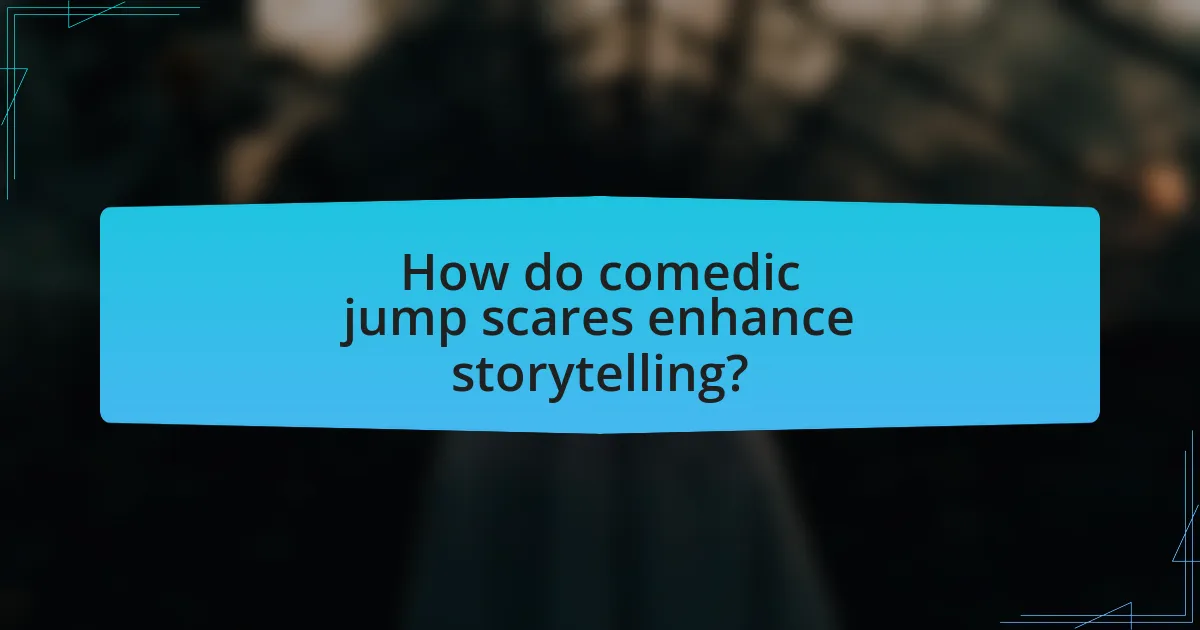
How do comedic jump scares enhance storytelling?
Comedic jump scares enhance storytelling by creating unexpected moments that elicit laughter while simultaneously advancing the plot. These jump scares disrupt the audience’s expectations, leading to a heightened emotional response that can deepen engagement with the narrative. For instance, films like “Scary Movie” utilize jump scares not only for shock value but also to parody horror tropes, thereby enriching the comedic narrative. This technique effectively combines humor with suspense, allowing for character development and plot progression in a unique way that resonates with viewers.
What narrative purposes do jump scares serve in comedic contexts?
Jump scares in comedic contexts serve to create unexpected moments of surprise that elicit laughter through the juxtaposition of fear and humor. This technique plays on audience expectations, where the sudden shock is often followed by a humorous reaction or situation, effectively subverting tension. Research indicates that the combination of fear and laughter can enhance the overall comedic experience, as seen in films like “Scary Movie,” where jump scares are used to parody horror tropes while simultaneously delivering comedic relief. The effectiveness of this approach lies in its ability to engage viewers emotionally, making them more receptive to humor following a scare.
How can jump scares create tension and release in a comedic setting?
Jump scares can create tension and release in a comedic setting by leveraging the element of surprise to build anticipation and then subverting expectations for humor. In this context, the sudden shock of a jump scare generates a heightened emotional state, leading the audience to brace for a frightening outcome. However, when the scare is followed by a comedic twist or absurdity, it transforms the initial tension into laughter, effectively releasing the built-up anxiety. Research indicates that humor often arises from incongruity, and jump scares can serve as a setup for unexpected punchlines, enhancing the comedic effect. For example, films like “Scary Movie” utilize jump scares not just for fright but to create a humorous juxtaposition, demonstrating how the interplay of fear and comedy can engage audiences in a unique way.
What role do jump scares play in character development within comedies?
Jump scares in comedies serve to enhance character development by revealing vulnerabilities and eliciting genuine reactions from characters. When a character experiences a jump scare, it often exposes their fears, insecurities, or unexpected traits, allowing the audience to gain deeper insights into their personality. For instance, a character who initially appears brave may react with fear, showcasing a more relatable and human side. This contrast can lead to character growth, as they confront their fears or learn to cope with unexpected situations. Additionally, the comedic timing of jump scares can create moments of levity, allowing characters to bond over shared experiences of surprise and fear, further enriching their relationships and development throughout the narrative.
How do filmmakers balance humor and horror in jump scares?
Filmmakers balance humor and horror in jump scares by strategically timing comedic elements to provide relief from tension. This technique often involves using a setup that builds suspense, followed by a sudden scare that is immediately undercut by a humorous reaction or situation. For example, in films like “Shaun of the Dead,” the juxtaposition of a frightening moment with a comedic character response creates a unique blend that enhances both the scare and the humor. This method is effective because it plays on audience expectations, allowing them to experience a range of emotions in quick succession, which can amplify the impact of both the jump scare and the comedic relief.
What techniques are used to ensure jump scares remain light-hearted?
Techniques used to ensure jump scares remain light-hearted include the use of comedic timing, exaggerated sound effects, and playful visual gags. Comedic timing allows for a build-up that leads to a sudden release, making the scare feel more like a joke than a threat. Exaggerated sound effects, such as cartoonish noises, soften the impact of the scare, making it less frightening. Playful visual gags, like unexpected character reactions or absurd scenarios, further contribute to a light-hearted atmosphere, ensuring that the audience is more inclined to laugh than feel fear. These techniques create a balance between surprise and humor, effectively transforming the jump scare into a comedic moment.
How do filmmakers avoid crossing the line into genuine fright?
Filmmakers avoid crossing the line into genuine fright by carefully balancing tension and humor, ensuring that jump scares are used in a context that elicits laughter rather than fear. This technique often involves timing the scares with comedic elements, such as absurd situations or exaggerated reactions, which diffuses the potential for genuine terror. For example, films like “Scary Movie” utilize parody to transform traditional horror tropes into comedic moments, effectively maintaining a light-hearted atmosphere while still delivering jump scares. This strategic use of humor alongside suspense allows filmmakers to engage audiences without inducing real fear.
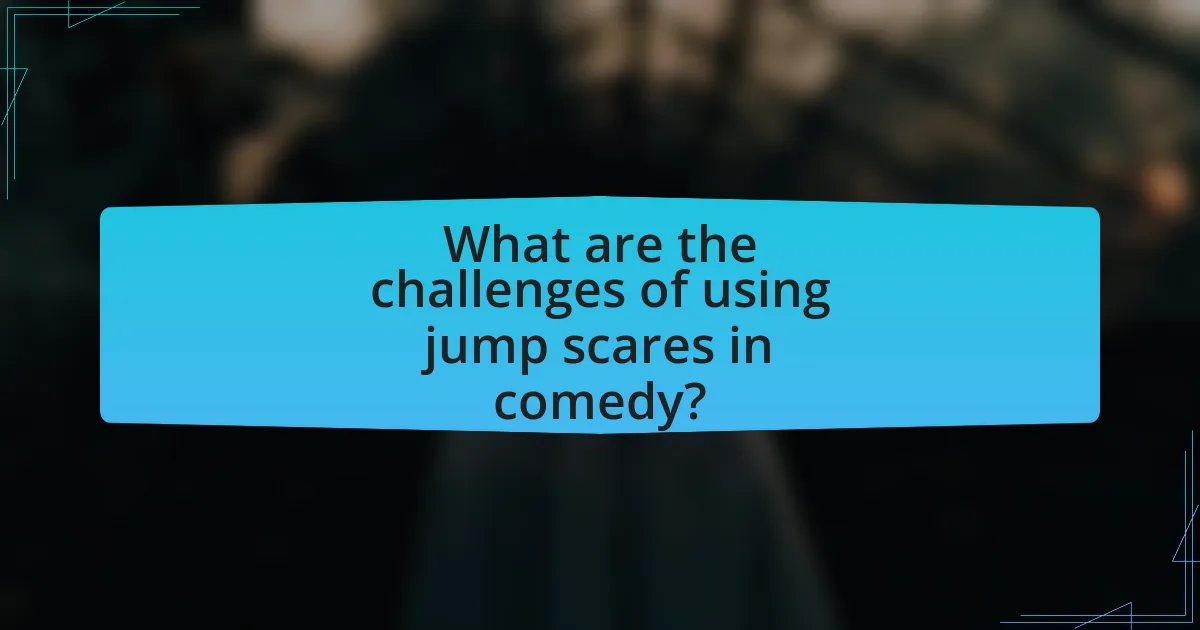
What are the challenges of using jump scares in comedy?
The challenges of using jump scares in comedy include the risk of disrupting comedic timing and alienating the audience. Jump scares, typically designed to provoke a sudden shock, can interrupt the flow of humor, leading to a disjointed viewing experience. Additionally, if the jump scare is too intense or unexpected, it may cause discomfort rather than laughter, which can result in a negative reception from the audience. Research indicates that effective comedy relies on rhythm and pacing, and the abruptness of a jump scare can undermine these elements, making it difficult to achieve the desired comedic effect.
What pitfalls should creators avoid when incorporating jump scares?
Creators should avoid overusing jump scares, as excessive reliance can desensitize audiences and diminish their effectiveness. When jump scares are frequent, they lose their impact, leading to viewer fatigue and reduced emotional engagement. Additionally, creators should ensure that jump scares are contextually relevant to the narrative; poorly timed or irrelevant scares can disrupt the flow of the story and alienate the audience. Finally, creators must be cautious about the sound design associated with jump scares; abrupt loud noises can cause discomfort rather than fear, potentially alienating viewers rather than enhancing their experience.
How can overuse of jump scares detract from comedic impact?
Overuse of jump scares can detract from comedic impact by desensitizing the audience to surprise elements, which diminishes the effectiveness of both humor and tension. When jump scares are excessively employed, they create a predictable pattern that audiences begin to anticipate, leading to reduced emotional responses. Research indicates that effective comedy relies on timing and the element of surprise; thus, when jump scares become routine, they undermine the spontaneity necessary for humor. This pattern can lead to a disengagement from the comedic narrative, as viewers may become more focused on the jump scares rather than the comedic elements intended to elicit laughter.
What are the risks of alienating audiences with poorly executed jump scares?
Poorly executed jump scares risk alienating audiences by breaking immersion and causing frustration. When jump scares are predictable or lack proper buildup, they can lead to audience disengagement, as viewers may feel manipulated rather than genuinely scared. Research indicates that effective horror relies on suspense and emotional investment; thus, poorly timed scares can diminish the overall experience, leading to negative reviews and reduced viewer retention. For instance, a study published in the Journal of Media Psychology found that audiences prefer horror films that maintain tension over those that rely solely on abrupt shocks, highlighting the importance of execution in maintaining audience engagement.
How can creators effectively implement jump scares in comedic works?
Creators can effectively implement jump scares in comedic works by timing the scare to coincide with a comedic setup, creating a contrast that enhances both the shock and humor. This technique relies on the audience’s expectation of a joke, which can be subverted by an unexpected scare, leading to a heightened emotional response. For example, films like “Scary Movie” utilize this method by placing jump scares immediately after punchlines, leveraging the audience’s laughter to amplify the surprise. Research indicates that the juxtaposition of humor and fear can create a unique viewing experience, as seen in studies on emotional responses to mixed-genre films, which show that audiences often find such combinations more engaging.
What best practices should be followed for successful comedic jump scares?
Successful comedic jump scares should utilize timing, misdirection, and character development. Timing is crucial; the scare should occur at a moment when the audience is least expecting it, often following a build-up of tension. Misdirection enhances the comedic effect by leading the audience to anticipate one outcome while delivering a surprise that contrasts with their expectations. Character development is essential, as well-rounded characters make the jump scare more impactful; audiences are more likely to react when they care about the characters involved. Research indicates that effective comedic jump scares balance humor and surprise, creating a unique experience that elicits laughter and shock simultaneously.
How can feedback from test audiences inform the use of jump scares?
Feedback from test audiences can significantly inform the use of jump scares by revealing audience reactions and preferences regarding timing, intensity, and placement of scares. This feedback allows filmmakers to adjust the frequency and style of jump scares to enhance comedic effect while maintaining suspense. For instance, studies have shown that audiences often respond positively to jump scares that are unexpected yet cleverly integrated into comedic moments, as seen in films like “Scary Movie.” By analyzing audience responses, filmmakers can refine jump scare techniques to maximize both humor and shock, ensuring a balanced experience that resonates with viewers.
What tips can enhance the effectiveness of jump scares in comedy?
To enhance the effectiveness of jump scares in comedy, timing and context are crucial. Properly timed jump scares, often placed after a moment of calm or humor, can maximize surprise and laughter. Research indicates that the juxtaposition of humor and fear can create a heightened emotional response, making the scare more impactful. For instance, films like “Scary Movie” utilize this technique effectively by integrating comedic elements just before a jump scare, which amplifies the audience’s reaction. Additionally, using relatable characters in absurd situations can increase the comedic effect, as viewers are more likely to connect with the characters’ fear, leading to a stronger comedic payoff.

